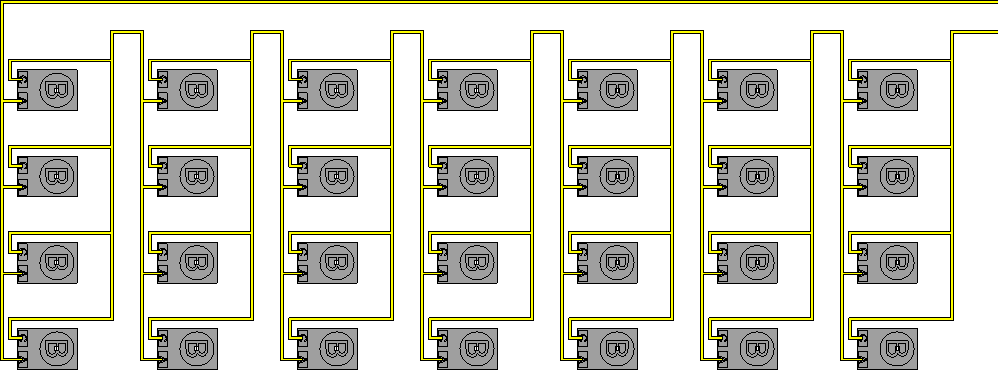Hirudin
Newly Enlightened
- Joined
- Sep 5, 2004
- Messages
- 26
I'm planning to build a large RGB array using Luxeon Rebels and the CCHIPO driver. Currently I'm planning to have 28 sets of LEDs.
By the looks of it, the blue LEDs should be run at 385 mA, which will make their typical Vf 3.2.
The CCHIPO driver has an output limit of 39 V and 45 W. So, if wired in series I'll be limited to 12 LEDs (3.2 V * 12 = 38.4 V). But this will only be using 14.784 W (38.4 V * 385 mA = 14.784 W); well bellow the CCHIPO's 45 W limit.
It seems to me that I could run 7 sets of 4 parallel wired blue LEDs in series (like the image at the bottom). The way I see it, each set of parallel LEDs should have a Vf of 3.2 and 1.54 A. All 7 sets would have a total Vf of 22.4 and 1.54 A for a total of 34.496 W.
22.4 V and 34.496 W are both well bellow CCHIPO's limits.

The problem is, I wont be able to get binned LEDs, so the exact Vf of each LED will be unknown. Also I've heard that the Vf will change over the life of the LED and will also change when the bulb warms up.
What issues are there with wiring LEDs with different Vfs in parallel?
By the looks of it, the blue LEDs should be run at 385 mA, which will make their typical Vf 3.2.
The CCHIPO driver has an output limit of 39 V and 45 W. So, if wired in series I'll be limited to 12 LEDs (3.2 V * 12 = 38.4 V). But this will only be using 14.784 W (38.4 V * 385 mA = 14.784 W); well bellow the CCHIPO's 45 W limit.
It seems to me that I could run 7 sets of 4 parallel wired blue LEDs in series (like the image at the bottom). The way I see it, each set of parallel LEDs should have a Vf of 3.2 and 1.54 A. All 7 sets would have a total Vf of 22.4 and 1.54 A for a total of 34.496 W.
22.4 V and 34.496 W are both well bellow CCHIPO's limits.

The problem is, I wont be able to get binned LEDs, so the exact Vf of each LED will be unknown. Also I've heard that the Vf will change over the life of the LED and will also change when the bulb warms up.
What issues are there with wiring LEDs with different Vfs in parallel?


